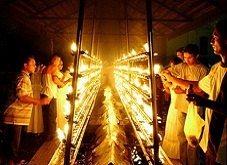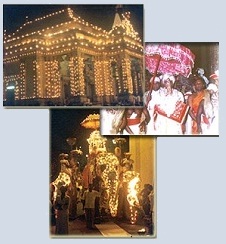
| HOME | GAMPAHA | NEGOMBO | CONTACT US | ABOUT US |
The city of Kelaniya was the capital city of King Kelanitissa, a scion of the dynasty of King Devanam Piya Tissa (third century B.C.) of Anuradhapura. The royal family of Magama in the south was connected to the royalty of Kalyani by the marriage of King Kavantissa of Magama to Vihara Maha Devi, the daughter of Kelanitissa. It was this matrimony that resulted in the birth of King Dutugamunu (second century B.C.) of Ruhuna, the hero of the nation, during whose period Sri Lanka enjoyed a golden era, both politically and culturally. |
 |
|
Situated about six miles from Colombo, set within a sacred area of around ten acres, the Kelani Vihara stands beside the Kelani river as evidence of a Buddhist tradition in this country. The spot on which this vihara stands derived its sanctity in the Buddhist era 2531, with the third visit of the Buddha to this country. He hallowed this ground by His visit accompanied by 500 Arahants.
The fact that the Buddha visited the spot on a Wesak day on the invitation of King Maniakkhika is given in the historic epics of Sri Lanka. |
 |
|
| The Naga King, according to these chronicles had invited the Buddha to a repast at this spot which following the expounding of the Dhamma was consecrated and on which the King had built a vehera wherein the Buddha's hair and the utensils use at the repast together with the seat on which the Buddha sat were buried. However with the advent of time and the destruction of the vihara by the foreign invaders has resulted in the original dageba being lost today. At this historic temple a procession known as "The Duruthu Perahera'' (Kelani Procession) in held on the pre - full moon day of the month of January every year, on this occasion hundreds and thousands of people from all parts of the country, and hundreds of foreign tourists trek their way to the temple purlieu to witness this spectacular pageant. |
|
